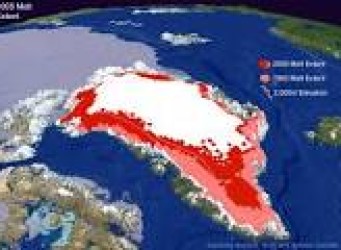Continuing on the theme of showing the evidence and impact of a warming planet, here’s more on how the melting of the glaciers in Greenland is speeding up. This, of course, will raise sea levels. The impact of that will be enormous especially for all the human (and plant and animal life as well) life and infrastructure along coastlines. Not only will a higher sea level inundate low lying areas but increased frequency and intensity of storms will exacerbate storm surge and damage.
Buckle up. We’re headed for a stormy future. The faster we quit pumping CO2 into the atmosphere the better.
Greenland Ice Sheet Melting Faster Than Ever Recorded
The Greenland ice sheet is melting at its fastest rate in at least 400 years, new research suggests. And the melting is only speeding up.A study published this week in Geophysical Research Letters finds that melt rates in western Greenland have been accelerating for the last few decades. Melting is now nearly double what it was at the end of the 19th century, the research suggests.And the scientists say a significant increase in summertime temperatures — to the tune of about 1.2 degrees Celsius since the 1870s — is mainly to blame.
Future warming may only continue to enhance the melting, the researchers warn — a major concern when it comes to future sea-level rise.“If we’re going to make accurate predictions of sea-level rise, we have got to understand how Greenland responds to warming,” said study co-author Erich Osterberg, a climate scientist at Dartmouth College, in an interview with E&E News.Much of the recent attention on Greenland’s ice loss has focused on icebergs breaking away from the ice sheet’s glaciers, eye-catching events that often draw media attention and capture the public’s imagination. But research suggests that melting from the surface of the ice sheet actually accounts for more than half of Greenland’s ice loss. So the factors influencing surface melt rates are just as important to understand when predicting future sea-level rise.
Satellite observations and ice models have helped scientists estimate surface melt rates from the last few decades. But there’s another method scientists can use to confirm these estimates on the ground.
While much of the meltwater runs off into the ocean, a substantial portion trickles back into the snow as it rolls down the ice sheet and refreezes.
“The record of that melt event is then locked into the glacier,” Osterberg noted.
Scientists can retrieve it by drilling into the surface of the ice sheet and drawing out a long core of ice, containing many layers of refrozen water, which they may then analyze in a laboratory. These ice cores can provide all kinds of valuable information about the age of the ice and the timing of melt events on the ice sheet.
Osterberg, along with lead study author Karina Graeter and a team of other researchers, voyaged to western Greenland to investigate in person. In a region known as the “percolation zone,” where meltwater tends to trickle back into the snow and refreeze, they drilled beneath the surface and extracted seven ice cores for analysis.
The cores provided a record of melting events dating back to the year 1550. They suggest that melt rates in the region have been significantly increasing since the early 1990s, and are currently higher than they’ve been at any other point in the record.
The researchers used models informed with historical climate data to investigate some of the climatic factors influencing melt rates from one year to the next over the last century. Fluctuations in ocean temperatures and certain atmospheric circulation patterns were shown to have a major influence on year-to-year variations in melt rates since the 1870s.
That’s important to note, because these oceanic and atmospheric patterns may change under the influence of future climate change. Scientists are still debating how they may be affected, but the new findings suggest that a better understanding will be critical to making accurate short-term predictions about melting and sea-level rise.
That said, ongoing warming is still likely to be the biggest influence on long-term melting trends. Despite many fluctuations in weather conditions over the last century, the scientists noticed that the oceanic and atmospheric conditions were nearly identical at the end of the 19th century and in the early 2000s — yet melt rates in the 2000s were nearly double what they were a century ago.
The major difference between these two time periods is that summer air temperatures had warmed by more than a degree Celsius in the intervening years because of ongoing climate change. These findings suggest that, all other weather conditions held equal, human-caused warming is the greatest long-term factor in Greenland’s surface melt rates.
And if melting has already doubled in the last 100 years, continued warming may mean that surface melt becomes an even greater contributor to sea-level rise in the coming years.
“Essentially, the weather patterns that control these year-to-year changes become less and less important when you look over longer time scales,” Osterberg said. “Several decades into the future, the long-term warming trend from greenhouse gases — that’s going to dominate the signal.”



